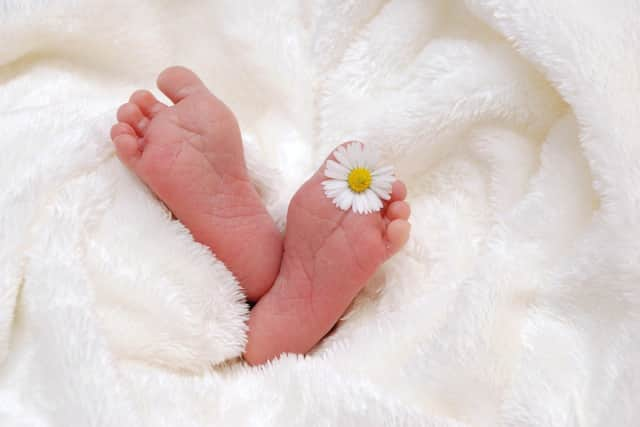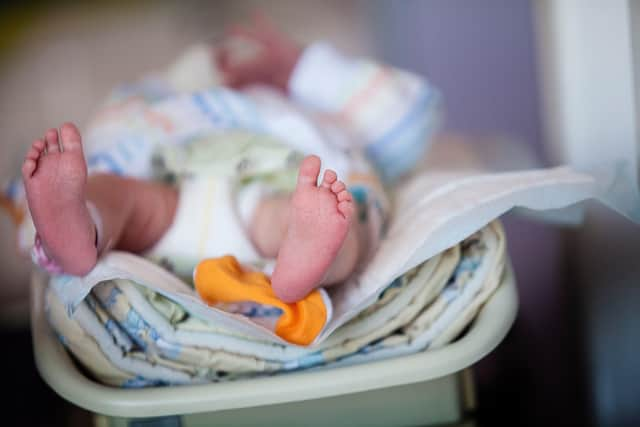The NI areas where mums are most likely to have the biggest babies
and live on Freeview channel 276
A range of factors can influence the likelihood of having an unusually large baby, including a mother’s weight and age, genetics, gestational diabetes, and a baby being overdue.
How big is a big baby?
Babies are considered unusually large if they weigh at least 8lb 13oz, or four kilograms – the equivalent of four bags of sugar. The medical term is foetal macrosomia.


Advertisement
Hide AdAdvertisement
Hide AdBabies this size can lead to complications during labour, and mothers are more likely to need a caesarian section.
Analysis of data from health bodies across the UK nations shows between one in seven and one in 10 babies have macrosomia, with those in Northern Ireland most likely to be on the chunkier side.
Where are Northern Ireland’s biggest babies?
Figures for each of Northern Ireland’s local council districts reveal the areas with the biggest babies.


The biggest babies came from Newry, Mourne and Down while women in Belfast were the least likely to have large babies.
Advertisement
Hide AdAdvertisement
Hide AdThere was significant variation across the country as the following statistics reveal.
Antrim and Newtownabbey
Total babies born: 1,630
Babies weighing 4kg and over: 236
Proportion of babies weighing 4kg and over: 14.5%
Higher or lower than NI average: higher
Ards and North Down
Total babies born: 1,506
Babies weighing 4kg and over: 205
Proportion of babies weighing 4kg and over: 13.6%
Higher or lower than NI average: lower
Armagh City, Banbridge and Craigavon
Total babies born: 2,836
Babies weighing 4kg and over: 364
Proportion of babies weighing 4kg and over: 12.8%
Higher or lower than NI average: lower
Belfast
Total babies born: 4,281
Babies weighing 4kg and over: 510
Proportion of babies weighing 4kg and over: 11.9%
Higher or lower than NI average: lower
Causeway Coast and Glens
Total babies born: 1,552
Babies weighing 4kg and over: 225
Proportion of babies weighing 4kg and over: 14.5%
Higher or lower than NI average: higher
Derry City and Strabane
Total babies born: 1,856
Babies weighing 4kg and over: 267
Proportion of babies weighing 4kg and over: 14.4%
Higher or lower than NI average: higher
Fermanagh and Omagh
Total babies born: 1,476
Babies weighing 4kg and over: 226
Proportion of babies weighing 4kg and over: 15.3%
Higher or lower than NI average: higher
Lisburn and Castlereagh
Total babies born: 1,823
Babies weighing 4kg and over: 259
Proportion of babies weighing 4kg and over: 14.2%
Higher or lower than NI average: higher
Mid and East Antrim
Total babies born: 1,477
Babies weighing 4kg and over: 190
Proportion of babies weighing 4kg and over: 12.9%
Higher or lower than NI average: lower
Mid Ulster
Total babies born: 2,115
Babies weighing 4kg and over: 315
Proportion of babies weighing 4kg and over: 14.9%
Higher or lower than NI average: higher
Newry, Mourne and Down
Total babies born: 2,363
Babies weighing 4kg and over: 364
Proportion of babies weighing 4kg and over: 15.4%
Higher or lower than NI average: higher
How does NI compare with England, Scotland and Wales?
Office for National Statistics (ONS) data shows one in 10 babies in England are unusually large.
Of 569,314 live births with weights recorded in 2020, 57,753 babies (10.1%) tipped the scales at four kilograms or more, with 596 of those weighing in at an incredible five kilograms, or 11lb.
In Scotland, around one in seven (13.3%) babies born in the year to March 2021 had macrosomia, according to Public Health Scotland (PHS) figures.
Advertisement
Hide AdAdvertisement
Hide AdFgures published by the Welsh Government for 2020 show 11.9% of live births involved a baby weighing at least four kilograms.
Unlike England, Scotland and Wales, Northern Ireland’s local figures include stillbirths, where birth weights are more likely to be low, which could bring down the proportion of large births when compared to other local areas in the UK.
What causes macrosomia - and are there any risks?
Some mothers are more likely to have larger than average babies, including those who have diabetes or develop diabetes during pregnancy, or have a high Body Mass Index (BMI).
Professor Asma Khalil, spokesperson for the Royal College of Obstetricians and Gynaecologists, said: “While there is an increased risk of complications if a baby is [four kilograms], the majority of women do not have any complications and their baby is born safely without any problems.”
Advertisement
Hide AdAdvertisement
Hide AdOne increased risk concerns shoulder dystocia, she said, where a baby’s shoulder gets stuck behind the pelvic bone during delivery. A mother will usually need extra help to free the baby.
She continued: “There is also an increased risk of the mother having heavier bleeding than normal after birth, and vaginal tears if having a vaginal birth.
“n some cases, if a woman had diabetes, they may be offered an early induction of labour, or a planned caesarean birth.”
Are babies getting bigger?
In recent decades the average baby born in England and Wales has become heavier, according to a 2018 study published in the British Medical Journal.
Advertisement
Hide AdAdvertisement
Hide AdSome anti-obesity campaigners have warned that unusually big babies are becoming increasingly common due to a rise in obesity among pregnant women.
Despite this, the data for each nation shows there has been no increased likelihood of newborns weighing four kilograms or more during the last decade across each UK nation.